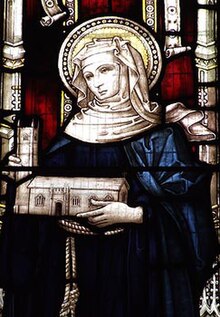Saint Buriana | |
|---|---|
 Stained glass window of Buriana, from St Buryan's Church | |
| Born | 6th century Ireland |
| Died | 6th century St Buryan, Cornwall |
| Venerated in | Eastern Orthodox Church Anglican Church Roman Catholic Church |
| Major shrine | St Buryan's Church, Cornwall |
| Feast | 1 May (Church of England), 4 June (Catholic Church) |
Buriana, also known as Berriona, Beriana, Buryan or Beryan,[1] was a 6th-century Irish saint, a hermit in St Buryan, near Penzance, Cornwall. Baring-Gould identifies her with the Irish saint Bruinsech.
Life[edit]
She is said to have been the daughter of an Irish king and travelled to Cornwall from Ireland in a coracle as a missionary to convert the local people to Christianity. According to the Exeter Calendar of Martyrology, Buriana was the daughter of a Munster chieftain.[2] One legend tells how she cured the paralysed son of King Geraint of Dumnonia. Buriana ministered from a chapel on the site of the parish church at St Buryan.
Veneration[edit]
The parish church of St Buryan, St Buryan's Church, is her primary patronage. Despite her official feast being on 1 May (recorded in the Exeter Martyrology), the parish church of St Buryan celebrates her feast on the Sunday nearest 13 May, in accordance with the old May Day of the Julian calendar. In the Roman calendar of saints, her feast is kept on 4 June.[3]
References[edit]
- ^ Ellis (1992), p. 6
- ^ Ellis, P. B. (1992) The Cornish Saints. Penryn: Tor Mark Press, p. 6
- ^ "St Buryan Parish Church TR19 6BA | St Buriana". www.stburyanchurch.org.uk. Retrieved 4 September 2023.

External links[edit]
![]() Media related to Buriana at Wikimedia Commons
Media related to Buriana at Wikimedia Commons
- Ford, David Nash (2006). "St Buriana". earlybritishkingdoms.com. Early British Kingdoms. Retrieved 2 May 2022.
- "Saint Buriana". stburyanchurch.org.uk. St Buryan parish church. Retrieved 2 May 2022.

Well, that’s interesting to know that Psilotum nudum are known as whisk ferns. Psilotum nudum is the commoner species of the two. While the P. flaccidum is a rare species and is found in the tropical islands. Both the species are usually epiphytic in habit and grow upon tree ferns. These species may also be terrestrial and grow in humus or in the crevices of the rocks.
View the detailed Guide of Psilotum nudum: Detailed Study Of Psilotum Nudum (Whisk Fern), Classification, Anatomy, Reproduction